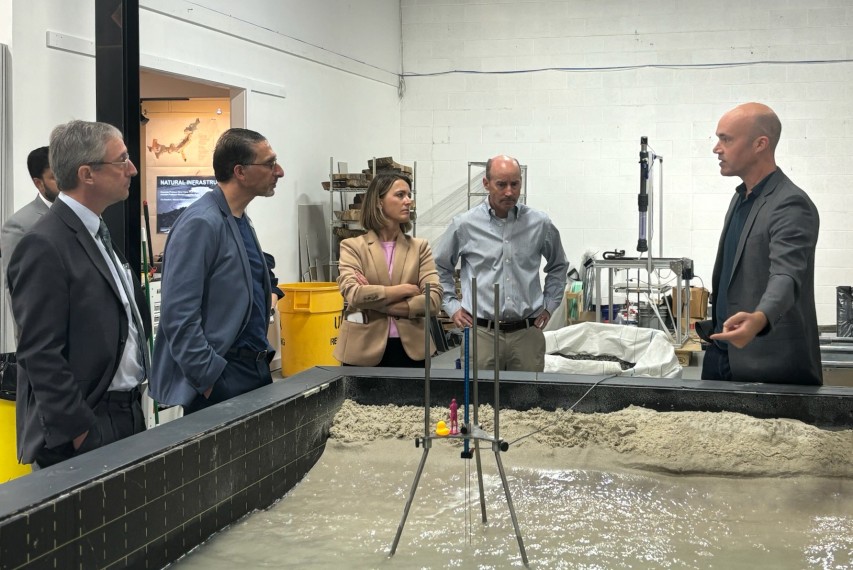
As climate change intensifies, UVA and the Department of Defense (DoD) pioneer efforts to safeguard both military and civilian communities. Through cutting-edge research and innovative technology, these institutions address critical environmental challenges, ensuring resilience and sustainability for future generations.
As storms approach the U.S. coastline, coastal communities spring into action, engaging in familiar routines: stocking up on nonperishables and water, sandbagging homes and businesses to prevent flooding, and even evacuating when necessary. However, preparations often begin long before storms are forecasted, as communities work to preserve their environments and minimize impacts on human life.
Residents aren’t the only ones concerned about the effects of severe weather. The Department of Defense (DoD) also deeply invests in severe weather and environmental protection as a national security issue, especially in areas where it maintains operations. Military installations face vulnerabilities from climate change, just like the communities where they are located, including extreme weather events, sea-level rise, and temperature fluctuations. By building resilience into infrastructure and operations, the DoD aims to safeguard these installations and ensure they remain functional under adverse conditions.
Recently, UVA showcased research and efforts to help communities respond to climate change challenges and improve quality of life during a visit from the leadership of the Strategic Environmental Research and Development Program (SERDP) and the Environmental Security Technology Certification Program (ESTCP). These programs harness cutting-edge science and technology to enhance the DoD’s environmental performance. Their work fosters partnerships and collaboration among academia, industry, the military services, and other federal agencies to reduce environmental impacts, like flooding, and protect communities and vital DoD infrastructure in those areas.
“Collaborations between government institutions like the Department of Defense and academic institutions like UVA are pivotal to advancing sustainable environmental practices,” said Lori L. McMahon, vice president for research. “This partnership not only strengthens our national security but also underscores our collective commitment to environmental stewardship.” UVA continues to make significant contributions to environmental science. Across Grounds, UVA researchers work to solve critical challenges at the intersection of climate change, our environment, and human well-being. These efforts position UVA as a leader in addressing complex global environmental challenges, from soil biogeochemistry to atmospheric sciences and coastal systems. Research leaders, faculty, and students hosted SERDP – ESTCP Executive Director Kim Spangler, and ESTCP Program Managers John La Scala, and Tim Tetreault to learn more.
“We were thrilled to share stories of UVA’s environmental research and its impact, both in Virginia and across the globe,” said Fred H. Epstein, associate vice president for research. “Including students shows the focus on the future of this type of research, particularly given its critical nature and importance to society.”
Highlights from the visit included:
- Madhav Marathe, director of the Biocomplexity Institute, shared how the institute studies large complex systems using digital twins and AI-driven analytics, and provided examples of how they apply those methods to urban systems.
- Jon Goodall, director of the Link Lab, discussed research focusing on water resources engineering and using cyber-physical systems for flood resilience, particularly in coastal communities experiencing sea-level rise and more frequent and intense storms.
- John Scully and Rob Kelly, co-directors of the Center for Electrochemical Science and Engineering in the Department of Materials Science and Engineering, presented research on the degradation and corrosion of engineered materials accelerated by interactions with their environment, as well as environmentally friendly corrosion mitigation strategies.
- Brian Davis and Michael Luegering, co-directors of the Natural Infrastructure Lab, use a landscape architecture approach to coastal resilience and natural infrastructure development.
- Members of the Environmental Institute, including Director Karen McGlathery, highlighted coastal work on adaptation and resilience in the Virginia region, including work on sea-level rise and saltwater intrusion into groundwater on the rural Eastern Shore, as well as storm flooding and water management in Norfolk and Hampton Roads.

The long history of collaboration between the Department of Defense and UVA exemplifies the power of partnership in tackling some of the most challenging issues facing the nation today. By leveraging cutting-edge research and technology, not only do they enhance national security, but they also foster sustainable practices that benefit both military and civilian communities.
The visit from SERDP and ESTCP leadership highlighted the critical role of academic research in developing innovative solutions to complex environmental issues. Together, these efforts underscore a shared dedication to safeguarding our environment and ensuring a safer, more sustainable future for all.